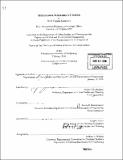| dc.contributor.advisor | Ralph Gakenheimer and Kenneth Kruckemeyer. | en_US |
| dc.contributor.author | Krambeck, Holly Virginia | en_US |
| dc.contributor.other | Massachusetts Institute of Technology. Dept. of Civil and Environmental Engineering. | en_US |
| dc.date.accessioned | 2006-11-07T12:00:00Z | |
| dc.date.available | 2006-11-07T12:00:00Z | |
| dc.date.copyright | 2006 | en_US |
| dc.date.issued | 2006 | en_US |
| dc.identifier.uri | http://hdl.handle.net/1721.1/34409 | |
| dc.description | Thesis (M.C.P.)--Massachusetts Institute of Technology, Dept. of Urban Studies and Planning; and, Thesis (S.M.)--Massachusetts Institute of Technology, Dept. of Civil and Environmental Engineering, 2006. | en_US |
| dc.description | Includes bibliographical references (p. 70-72). | en_US |
| dc.description.abstract | Although a significant number of trips are made by foot in developing cities, pedestrian infrastructure, amenities, and services are often neglected in municipal planning and budgets. Since helping city planners understand the scope and extent of local pedestrian conditions relative to other cities would be a positive step towards improving the quality of the pedestrian environment, I was retained by the World Bank to devise a walkability index, which would rank cities across the world based on the safety, security, and convenience of their pedestrian environments. To accomplish this task, I first generated a list of Index variables by studying existing tools for evaluating non-motorized transport and by consulting experts from a variety of related fields. After considering different methods for survey area selection, field data collection, and data aggregation, I created prototypes of the index and survey materials and organized field tests in cities throughout the world, including Beijing, Washington, and Delhi. I also oversaw a full-scale pilot in Ahmedabad, India, where 65 volunteers from the Centre for Environmental Planning and Technology (CEPT) conducted physical infrastructure, public agency, and pedestrian surveys in eight neighborhoods, which were selected using a random spatial sampling method. Results from these tests and pilot were used to refine the Index composition and data collection methodologies, resulting in a two-pronged tool. Since, out of practical necessity, the Global Walkability Index's robustness is limited by its simplicity (the Index is primarily intended to generate awareness of walkability as an important issue), | en_US |
| dc.description.abstract | (cont.) I developed an additional set of Extended Survey Materials that may be used to gather more detailed, site-specific data for use in developing investment and policy proposals. The Index is burdened by at least two significant limitations, namely that the notion of walkability itself is not well understood, paving the way for widespread misunderstanding and that the Index requires that most of the data be collected in the field, which presents difficulties in terms of funding, translation, and quality assurance. | en_US |
| dc.description.statementofresponsibility | by Holly Virginia Krambeck. | en_US |
| dc.format.extent | 135 p. | en_US |
| dc.format.extent | 8703722 bytes | |
| dc.format.extent | 8703472 bytes | |
| dc.format.mimetype | application/pdf | |
| dc.format.mimetype | application/pdf | |
| dc.language.iso | eng | en_US |
| dc.publisher | Massachusetts Institute of Technology | en_US |
| dc.rights | M.I.T. theses are protected by copyright. They may be viewed from this source for any purpose, but reproduction or distribution in any format is prohibited without written permission. See provided URL for inquiries about permission. | en_US |
| dc.rights.uri | http://dspace.mit.edu/handle/1721.1/7582 | |
| dc.subject | Urban Studies and Planning. | en_US |
| dc.subject | Civil and Environmental Engineering. | en_US |
| dc.title | The global walkability index | en_US |
| dc.type | Thesis | en_US |
| dc.description.degree | S.M. | en_US |
| dc.description.degree | M.C.P. | en_US |
| dc.contributor.department | Massachusetts Institute of Technology. Department of Civil and Environmental Engineering | |
| dc.contributor.department | Massachusetts Institute of Technology. Department of Urban Studies and Planning | |
| dc.identifier.oclc | 70254613 | en_US |
